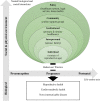A Golden Thread approach to transforming Maternal and Child Health in Singapore
- PMID: 35836151
- PMCID: PMC9284894
- DOI: 10.1186/s12884-022-04893-8
A Golden Thread approach to transforming Maternal and Child Health in Singapore
Abstract
Maternal and child health (MCH) in Singapore is entering a new phase, with challenges different to those faced 50 years ago. The advancement of medical technologies and access to MCH resources have led to a dramatic fall in maternal and infant mortality rates. However, there has been a steep rise in the rates of obesity and related metabolic diseases. Alongside this is an emerging mental wellness challenge, with one in ten women experience depression across pre-, during and post-pregnancy. Maternal obesity and mental disorders before and during pregnancy not only increase a woman's risk of pregnancy complications, but also result in increased risks in the offspring of childhood obesity, behavioral disorders and later life metabolic disease, catalyzing vicious cycles of disease. Thus, there is a pressing need to transform the current MCH system to address a burgeoning metabolic and mental health challenge for Singapore. Initiating interventions during preconception and continuing into the postpartum has the potential to confer long-term maternal-child benefits, promoting virtuous cycles of health. However, the current MCH system emphasizes antenatal care and lacks focus on the equally, if not more important, preconception, postpartum and inter-pregnancy stages. We describe a new model-of-care framework that integrates a life-course approach to health across preconception, pregnancy and postpartum phases, with the social-ecological model comprising individual, interpersonal, institutional, community and policy as the major targets for health promotion interventions. This "golden thread" approach is being established at the Singapore KK Women's and Children's Hospital (KKH), to address both metabolic and mental health challenges to achieve the goal of a thriving, healthy nation. This new model-of-care is set up in KKH as a pilot program known as Healthy Early Life Moments in Singapore (HELMS). HELMS will reach out to women planning to conceive through coordinated interventions across preconception, pregnancy and postpartum periods. A mobile health platform is being developed to facilitate interventions and engage participants in the program through a digital, personalized and interactive approach. This new model-of-care is designed to secure a population with healthy life cycles, by influencing each life-course, early-in-life, to provide the best start for generations to come.
Keywords: Healthcare framework, Life-course, Maternal and child Health, Mental health, Metabolic disease, Non-communicable disease, Singapore, Transformation.
© 2022. The Author(s).
Conflict of interest statement
KMG has received reimbursement to speak at conferences sponsored by companies selling nutritional products, and is are part of an academic consortium who have received research funding from Abbott, Nutrition, Nestle and Danone. Other authors declare that the research was conducted in the absence of any commercial or financial relationships that could be constructed as a potential conflict of interest.
Figures







References
-
- Black RE, Walker N, Laxminarayan R, Temmerman M. Reproductive, Maternal, Newborn, and Child Health: Key Messages of This Volume. In: Black RE, Laxminarayan R, Temmerman M, Walker N, editors. Reproductive, Maternal, Newborn, and Child Health: Disease Control Priorities. 3. Washington (DC): The International Bank for Reconstruction and Development / The World Bank; 2016. pp. 1–24.
-
- Vollset SE, Goren E, Yuan CW, Cao J, Smith AE, Hsiao T, et al. Fertility, mortality, migration, and population scenarios for 195 countries and territories from 2017 to 2100: a forecasting analysis for the Global Burden of Disease Study. Lancet. 2020;396:1285–1306. doi: 10.1016/S0140-6736(20)30677-2. - DOI - PMC - PubMed
-
- Population Trends: Fertility . Republic of Singapore: Department of Statistics. Ministry of Trade & Industry; 2020.
-
- World Health Organization, UNICEF, United Nations Population Fund, World Bank Group and the United Nations Population Division. Maternal mortality: Levels and trends 2000 to 2017. Geneva: World Health Organization (2019). https://www.who.int/reproductivehealth/publications/maternal-mortality-2... (Accessed 7 Aug. 2021).
MeSH terms
Grants and funding
LinkOut - more resources
Full Text Sources
Medical

